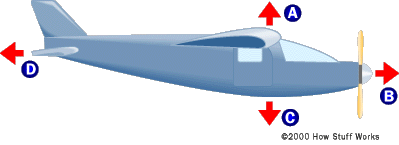Air Drag

How Stuff Works
When anything is moving in the air, there is a resistive force of the air
pushing back. This is known as Air Drag. On the picture above, air drag is
represented by the letter 'D'. Air drag is dependent on a few factors such
as the density of air, area of the air plane and the drag coefficient. This
is the equation for air drag:
R=(1/2)DpAv^2
For the equation, the different parts are:
R=resistive force
D=drag coefficient
p=density of the air
A=cross sectional area of object
v=velocity
If we crumpled up a paper airplane into a ball and dropped it from the top
of a building and there was wind, we could look at the forces on the crumpled
airplane as the downward force of gravity and the opposite force of air resistance.
Because the force of gravity is equal to the mass times gravity (Fg
= mg) we can add the forces on the ball into the equation:
F = mg - (1/2)DpAv^2
Air resistance plays a large part in the flight of paper airplanes by limiting
the flight distance. If the air resistance was too high, the paper airplane
wouldn't go anywhere. It would be like trying to throw a paper airplane under
water. The design of a paper airplane revolves somewhat around the air resistance
and the attempt to lessen the cross sectional area of the paper airplane.
The less area that is perpendicular to the horizontal path of the airplane
the less ressistance will be experienced.

